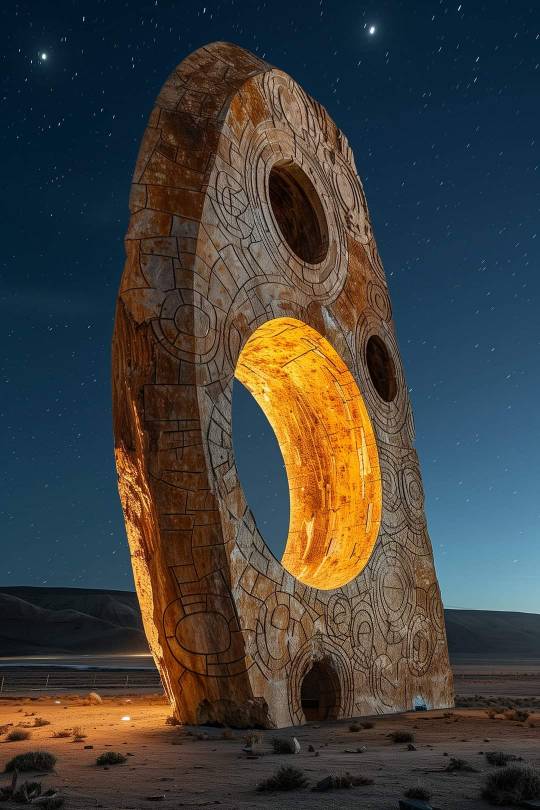#ancient artifacts
Text


George Washington's 250-Year-Old Cherries Found Buried at Mount Vernon
Archaeologists found something incredibly rare in the cellar of George Washington's home at Mount Vernon: Two intact jars of cherries buried in the basement of the first U.S. president's house.
Nick Beard, project archeologist at Mount Vernon, said on Tuesday that he had been excavating the basement "for quite a while" when he saw the lip of one of the jars in November.
When the bottle started to peek out from the earth, he proceeded carefully but said he didn't think it would turn out to be anything out of the ordinary, adding that it's common to find wine bottles and glasses at the site about 15 miles south of Washington, D.C.
In fact, Beard stepped away from the bottles to help on a more immediate project. Only when he returned several weeks later did he realize what he discovered.
As he worked, more and more glass became exposed. He tried to wiggle the glass out of its resting place, but when he did his fingers got a little wet.
That's when he noticed whatever he was working on was full of liquid.
"Which means if it's that full of liquid then it has to be intact enough to hold that liquid," said Beard. "That's not common, so that immediately got me excited."
Uncovered jars reveal centuries-old cherries
When Beard further revealed the jars, he called other archeologists to come check his findings.
The jars were fully excavated on March 22. The cherries were removed from the bottles to help preserve the glass, but after April 30, the glass will be sent off for conservation. Its contents will be sent to a lab for analysis and be tested in a controlled environment by specialists, according to a press release from Mount Vernon.
"It's extraordinary," Jason Boroughs, principal archaeologist at Mount Vernon, saying something similar has only happened twice in Virginia in the past six decades:
The latest discovery is a part of the privately funded $40 million Mansion Revitalization Project at Mount Vernon.

What was in the jar?
Beard and Boroughs said that cherries and a mystery liquid were found in the jar. And the cherries, Boroughs said, actually look like cherries, even after hundreds of years.
"They're plump, they have flesh, they have pits and stems," Boroughs said. "They don't look as if they've been sitting in a bottle for 250 years, although they have."
The liquid inside even smelled like cherry blossoms, according to Mount Vernon.
The cherries in the bottles were probably dry when they were buried, Boroughs said.

While the archeologists know what the cherries are, the liquid is still a bit of a mystery.
Lily Carhart, curator of the preservation collections at Mount Vernon, said it's possible the groundwater got into the bottle after the cork that sealed it deteriorated.
The liquid still needs to be tested, Boroughs said. And there is a small possibility it could've been a type of alcohol, like a brandy or cognac.
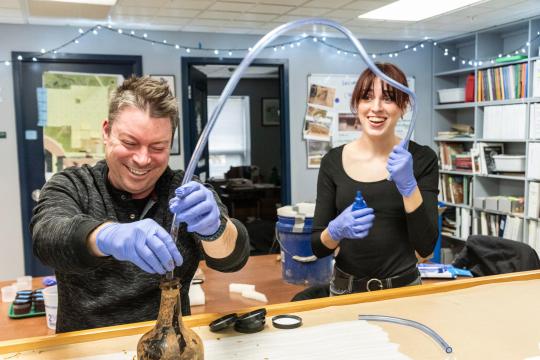

Why were the cherries buried?
Enslaved laborers picked the cherries, wiped them off to avoid condensation and placed them into the jar. Then, that jar was corked and buried sometime between 1758 and 1776, when both George and Martha Washington were living at the home, according to Boroughs.
He added that the method would've kept the fruit inside the bottle preserved for up to a year. It was one of the most popular ways to preserve berries and its how folks in colonial America preserved food before there were refrigerators.
"It pretty much keeps them isolated and sealed from the atmosphere, from air and from fungus and other things that could attack" he said.
According to Boroughs, the cherries were supposed to be served on George Washington's dinner table, but instead were forgotten and buried under a brick floor that was placed in the 1770s, sealing its fate as a sort of a "time capsule."



Can you still eat the cherries?
"You would not want to put that close to your face," Carhart said about the cherries.
Boroughs said that it could actually be possible to eat them, but "nobody wants to try."
Why is this discovery significant?
Boroughs said the discovery is remarkable because he "can't count the number of times 18th-century food remains have been found intact" the way the cherries were.
"We're the first people to touch these objects since they were put in the ground by an enslaved person," Boroughs said.
While the discovery itself is incredible, the archeologist said the stories that can be uncovered from it are just as amazing.
"We think of these items sort of as the material bits of lives that we can recover from the ground," Boroughs said. "These bottles tell stories. They're attached to people who had real lives and if we know how to put the pieces together, we can piece together something about their lives."
Beard added that it feels "surreal" to have such an "immediate connection with the people that lived back then."
By Julia Gomez.



#George Washington's 250-Year-Old Cherries Found Buried at Mount Vernon#Mount Vernon#George Washington#ancient artifacts#archeology#archeolgst#history#history news
27 notes
·
View notes
Text
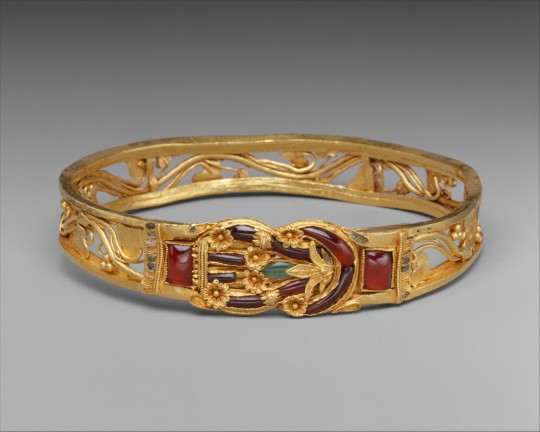
Gold armband with Herakles knot
Hellenistic period
3rd–2nd century BCE
Gold inlaid with garnets, emeralds, and enamel
3 1/2in. (8.9cm)
The Herakles knot on this sumptuous armband is enriched with floral decoration and inlaid with garnets, emeralds, and enamel. According to the Roman writer Pliny, the decorative device of the Herakles knot could cure wounds, and its popularity in Hellenistic jewelry suggests that it was thought to have the power to avert evil.
from The Metropolitan Museum of Art, New York
#greek art#hellenistic art#ancient artifacts#ancient art#antiquities#art history#archeology#hercules#carnelian#met museum#herakles
20 notes
·
View notes
Text
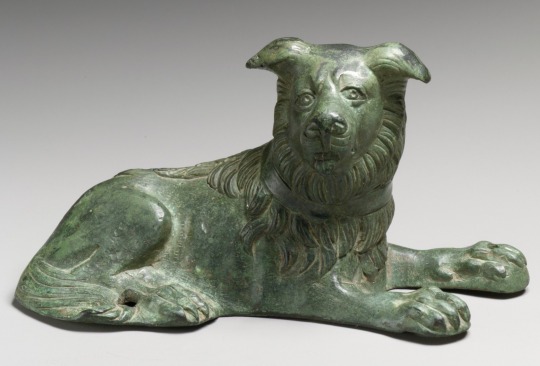
Bronze statuette of a dog
Roman
2nd-3rd century CE
#roman art#dogs#bronze#bronze statue#animals in art#ancient art#ancient people#ancient statue#statue aesthetic#aesthetic#beauty#ancient artifacts#artifacts#antiquities#beautiful animals#dogs of tumblr#cute dogs#modern art#art history#aesthetictumblr#tumblraesthetic#tumblrpic#tumblrpictures#tumblr art#tumblrstyle#artists on tumblr
1K notes
·
View notes
Text
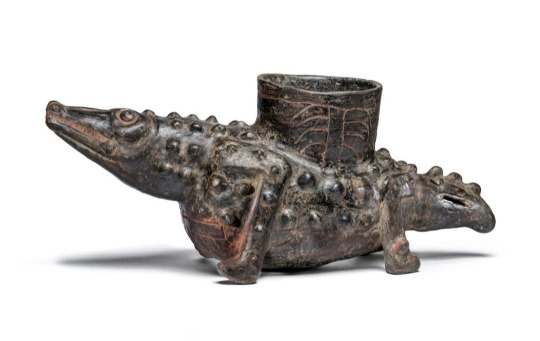
Mayan croc vessel, Mexico AD 300-600, Los Angeles Country Museum of Art
346 notes
·
View notes
Text

The Wijnaldum brooch
ig: @woedans / @museumperspective
272 notes
·
View notes
Photo

The “magic sphere” of Helios
Found in the Theater of Dionysus in 1866, this mystical object, dating back to the ~2nd-3rd century AD, is made of marble, shaped like a sphere, and depicts Helios, Greek Solar God.
Here He is representing a κοσμοκράτωρ, “master” or “lord” of the world. He is seated on a throne with a whip in one hand and three lit torches in the other. While the purpose of the object is a subject of many questions, many agree that it might have been used for magical rituals - perhaps by competitors in sportive and theatrical events in the theater it was found in.
More information: 🏺 🏺
#AES : ANTIGÜEDADES 💎#ancient greece#ancient history#ancient artifacts#greek art#ancient greek art#sphere of helios#I was looking into ancient solar magic and found the THING
787 notes
·
View notes
Text

93 notes
·
View notes
Text

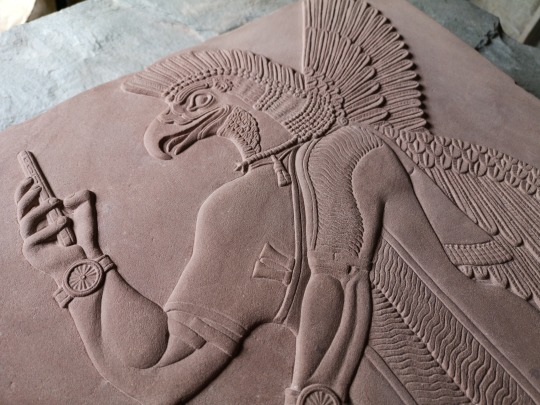

Out of place artifact.
Hand carved sandstone, based on an ancient Assyrian Winged Genie, but with a twist.
#carving#stone carving#art#traditional art#sculpture#assyrian#ancient history#archeology#history#ancient artifacts#mesopotamian art#mesopotamia#mesopotamian#genie#ancient art#ancientmonuments#antiquities#neoassyrian
132 notes
·
View notes
Text




Bloodsport of the Scrub Tortoises.
Tortoise boxing, the oldest documented martial art, was first referenced in the 5th century as a method of self-defense. It survives and is still practiced today, from prize fighting to special forces training!
Source: art compiled by martial historian Dusty Diamond
Frogiverse.com
#archaeology#history#art history#ancient artifacts#artifacts#tortoise#martial arts#mma#boxing#educational#worldbuilding#ufc#fighting#critters#animals#nature#fantasy#martialarts
103 notes
·
View notes
Text
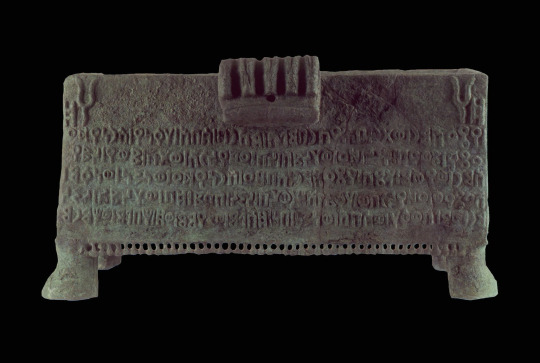
نقش سبئي يذكر "يمن" (𐩺𐩣𐩬) كلقب للإله أرنيدع، إله نشان اللتي ابقت قبائل الجوف متحدة في ذلك الوقت. القرن الثامن ق.م، اليمن.
Sabaic inscription mentions "Yemen" as an epithet of the god Aranyada', god of Nashan which kept the tribes of the Jawf united at the time. 8thC BC, Yemen.
63 notes
·
View notes
Text


A FOSSIL GINKGO LEAF
Colorado, USA
From the Paleocene (circa 58 - 55 million years ago) the clearly defined 31⁄4-inch wide Ginkgo cranei with well preserved striations, on original matrix. Reverse of matrix three further partial specimens of Ginkgo cranei.
63⁄4 x 67⁄8 x 3⁄4in. (17.1 x 17.5 x 1.9cm.).
#A FOSSIL GINKGO LEAF#colorado#paleocene period#ginkgo cranei#fossils#archeology#archeolgst#history#history news#ancient artifacts#nature
7K notes
·
View notes
Text
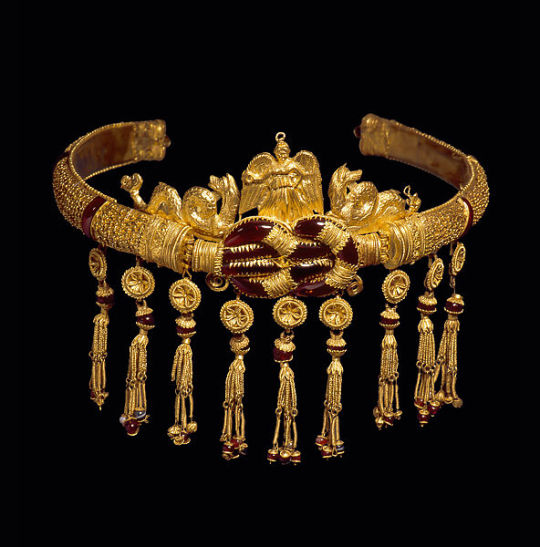
Greek Gold diadem with Hercules knot (250–150 BCE),
Gold, garnet, carnelian, sardonyx
3×9 1/8 in. (7.6 × 23.1 cm).
On loan to the Metropolitan Museum.
#greek art#ancient artifacts#ancient art#antiquities#antiquity#jewellery#archeology#met museum#art history#history#garnet#carnelian#sardonyx#heracles#hercules
2K notes
·
View notes
Text

Octopus vase from Palaikastro
c. 1500 BCE, painted stone
#ancient artifacts#ancient art#octopus#nature#wildlife#sea life#antiquities#ancient people#ancient culture#vessel#aesthetic#beauty#modern art#art history#aesthetictumblr#tumblraesthetic#tumblrpic#tumblrpictures#tumblr art#tumblrstyle#artists on tumblr
931 notes
·
View notes
Text
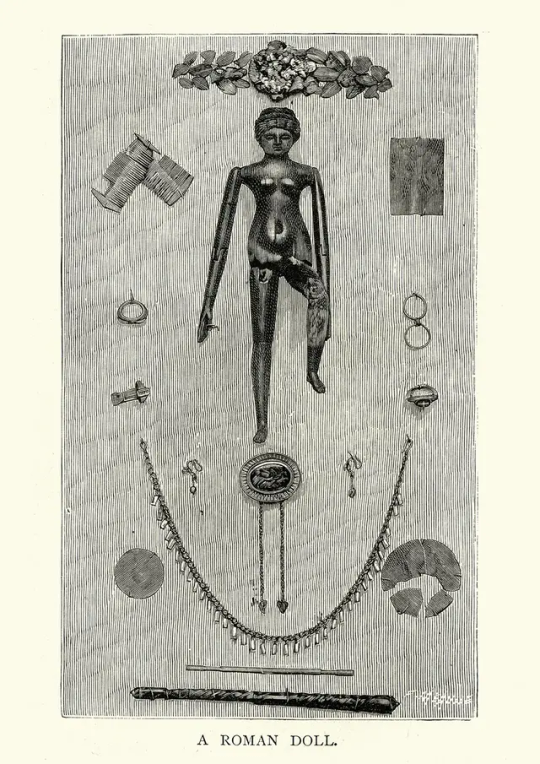

Source identifier: PCM (Hades Legacy Identifier / Struc ID) Content: Printed on border: "The above picture shows a jointed doll and other articles recently found in the sarcophagus of a young lady of ancient Rome, named Crepereia Trifena." Includes additional text.Content: Illegible engraver signature on image.
The Miriam and Ira D. Wallach Division of Art, Prints and Photographs: Picture Collection, The New York Public Library. "A Roman doll" The New York Public Library Digital Collections. 1894. https://digitalcollections.nypl.org/items/510d47e4-37c7-a3d9-e040-e00a18064a99
#Roman Doll#Crepereia Trifena#The New York Public Library#artifacts#ancient artifacts#doll#dolls#ancient#wooden articulated doll#articulated doll#jointed doll
51 notes
·
View notes
Text

Sew-on plaque with the image of Eros and Psyche. First centuries AD Kerch (?)
#psyche#eros and psyche#amor and psyche#cupid and psuche#amor#gold#art#ancient artifacts#ancient art#greek mythology#angels#angelwave#angelcore#autentico
36 notes
·
View notes
